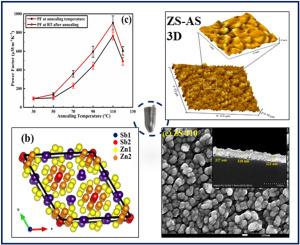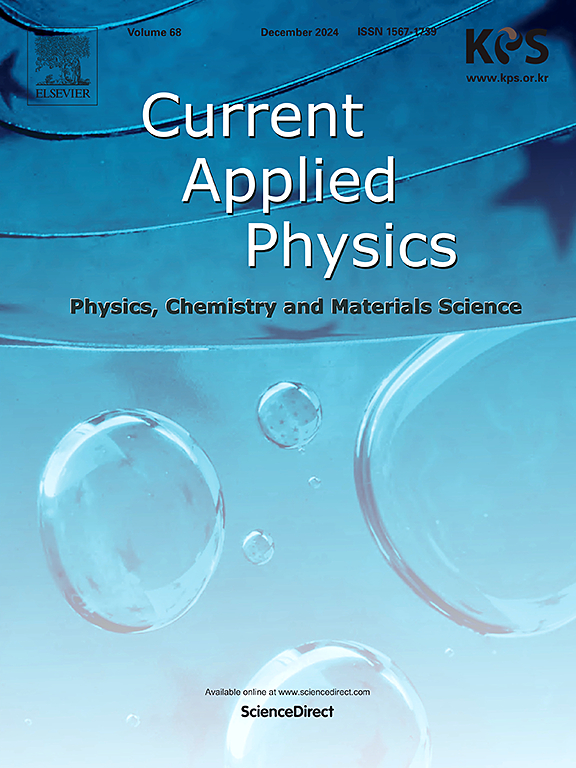热退火导致β-Zn4Sb3薄膜热电功率因数成倍提高
IF 3.1
4区 物理与天体物理
Q3 MATERIALS SCIENCE, MULTIDISCIPLINARY
引用次数: 0
摘要
在室温(303 K)下,采用沉积后热退火方法,β-Zn4Sb3薄膜的热电参数电导率、塞贝克系数和功率因数分别提高了102.56%、110.90%和712.76%。采用多相Rietveld细化分析来确定合成材料的相量化、晶格参数、原子位置和占位率、键长和角度以及晶体结构。热蒸发β-Zn4Sb3薄膜在303 K下退火6 h后,电导率、塞贝克系数和功率因数分别达到1.58×104Sm−1、232 μVK−1和764 μWm−1K−2的最大值。电导率的提高是由于退火导致带隙值降低、缺陷和晶界减小、晶粒尺寸增大和生长方向重定向所致。塞贝克系数值的增加是由于表面粗糙度增加所促进的能量过滤作用。研究了薄膜的结构特征,揭示了热退火过程中晶体生长方向的改变。光学特性研究表明,未退火的β-Zn4Sb3薄膜带隙能值为1.28 eV。经高温退火后的薄膜表面形貌显示晶粒聚集,薄膜平均厚度为323 nm。研究了薄膜的地形特征,以可视化三维表面图,线轮廓和确定表面粗糙度。本文章由计算机程序翻译,如有差异,请以英文原文为准。

Thermal annealing induced multifold enhancement in thermoelectric power factor of β-Zn4Sb3 thin films
In the present work, thermoelectric parameters electrical conductivity, Seebeck coefficient and power factor of β-Zn4Sb3 thin films at room temperature (303 K) were enhanced by 102.56 %, 110.90 % and 712.76 % respectively using post-deposition thermal annealing approach. Multiphase Rietveld refinement analysis was implemented to determine phase quantification, lattice parameters, atomic positions and occupancies, bond lengths & angles and crystal structure of the synthesized material. Maximum electrical conductivity, Seebeck coefficient and power factor values of , 232 and 764 at 303 K were obtained after annealing of thermally evaporated β-Zn4Sb3 thin films for 6 h. Enhancement in electrical conductivity values were attributed to lowered band gap values, reduced defects & grain boundaries, large crystallite sizes and reorientation of growth direction caused by annealing. Enhancement in Seebeck coefficient values were attributed to the energy filtering effects promoted by increasing surface roughness. Structural characteristics of thin films were investigated, revealing reorientation of crystallites growth direction via thermal annealing. Investigation of optical characteristics revealed a band gap energy value of 1.28 eV for without annealed β-Zn4Sb3 thin film. Morphological properties of thin film surfaces revealed aggregation of grains due to annealing at elevated temperatures and average thin film thickness of 323 nm was determined. Topographical characteristics of thin films were investigated to visualize 3D surface maps, line profile and determine surface roughness.
求助全文
通过发布文献求助,成功后即可免费获取论文全文。
去求助
来源期刊

Current Applied Physics
物理-材料科学:综合
CiteScore
4.80
自引率
0.00%
发文量
213
审稿时长
33 days
期刊介绍:
Current Applied Physics (Curr. Appl. Phys.) is a monthly published international journal covering all the fields of applied science investigating the physics of the advanced materials for future applications.
Other areas covered: Experimental and theoretical aspects of advanced materials and devices dealing with synthesis or structural chemistry, physical and electronic properties, photonics, engineering applications, and uniquely pertinent measurement or analytical techniques.
Current Applied Physics, published since 2001, covers physics, chemistry and materials science, including bio-materials, with their engineering aspects. It is a truly interdisciplinary journal opening a forum for scientists of all related fields, a unique point of the journal discriminating it from other worldwide and/or Pacific Rim applied physics journals.
Regular research papers, letters and review articles with contents meeting the scope of the journal will be considered for publication after peer review.
The Journal is owned by the Korean Physical Society.
 求助内容:
求助内容: 应助结果提醒方式:
应助结果提醒方式:


